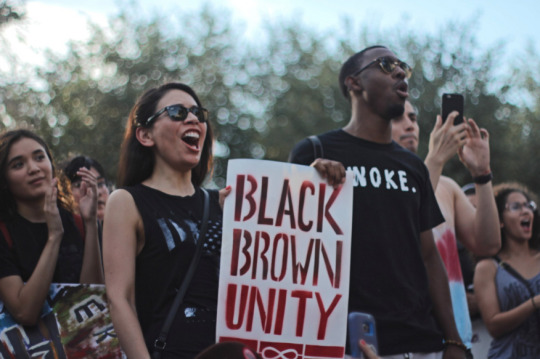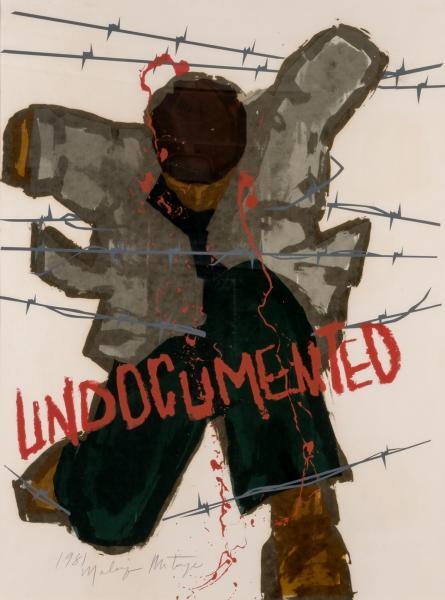Don't wanna be here? Send us removal request.
Text
Part 5 Discussion Post #2
For my last post for Part 5, I decided to write about the border wall. This wall is controversial and is meant to keep people out. It is ironic how many want Mexicans out, but big companies still hire them for cheap labor. If these people want people out, why hire them? This just shows the hatred people have and the racism they hold towards a group of people but wanting to save money at the same time. If anyone is vile and does not belong, it Is these people, not immigrants trying to better their lives. Starting in the 1900’s, America began to crack down on immigration. Surprise inspections began happening for people crossing the border, all while Americans could go vacation in Mexico at the beach with just their driver’s license. Starting here is where we see racism brewing. Construction for the wall began in the 1990’s under President Bill Clinton. From then even to now, the border wall was added on to and is still being built. With questionable leaders in office, this wall is still growing, and families are being ripped apart, all because of these so-called illegal immigrants who are not good for our country, so people say. These people have families they need to support and work the grueling jobs that many Americans would never touch, but Americans say jobs are being stolen. This is a controversial subject and people need to realize that we are all human.
http://www.worldstir.com/history-u-s-mexico-border-wall/
The article I attached is a brief history of the border wall.
0 notes
Text
Part 5 Discussion #1
For my first discussion post for Part 5, I saw an image in the introduction that caught my eye. It was of a Native American wearing a traditional headpiece asking the question, “Who’s the illegal alien, pilgrim?” I thought this was interesting because now many Americans see any one group that moves to the US from elsewhere is illegal and does not belong. America used to be known as a melting pot, where many cultures could come together and coincide as one. Now, America is full of many hateful people who feel it is their country and that they are the only culture that is best. This is quite unfortunate, because America was known for accepting those who needed a new life and wanted the American Dream. Seeing the image made me think a lot about how much our country has changed in terms of people’s views on immigration. Whether it be due to hateful people or even questionable politicians, this land was never ours to being with. We took it from others, made them suffer, and now here we are, many claiming it was theirs to begin with. Many Americans need a reality check of some sort and realize that we are all humans and that nobody deserves to suffer. Anyone should be able to move elsewhere for a better life, no matter if they are “illegal” or not.

The picture above is by Yolanda Lopez, made in 1981.
https://www.sfmoma.org/artwork/2017.218/
0 notes
Text
Part 4 Discussion Post #3
For my last post in Part 4, I decided to write about how important clothes were to Chicanos. They were a marginalized group and used clothes to protest and to even stand out. They did not want to assimilate and be forgotten. Throughout these readings, clothes are written about and shown how important they are. Many of us take our clothes for granted. We can dress how we want and not be stereotyped. Other groups are not so lucky. Many are perceived as “gangsters” by wearing baggy pants or hoodies. Many Chicanos and even blacks are stereotyped based on how they dress. To them, clothes are a matter of life or death to them. Society should not be this way. People should be perceived based on their actions, not by how they dress or the color of their skin. Stereotypes can be dangerous, but by protesting it using their clothes, maybe this can change.

https://www.vibe.com/2016/02/formation-the-little-known-history-of-the-brown-berets
0 notes
Text
Part 4 Discussion Post #2
My second post for Part 4 is going to be about how the Chicanos protested the Vietnam War. Although this was a small part of the reading, I found this most informational. Chicanos began to protest the large numbers of deaths in this war for their community. They also tied in inequalities in education and opportunities for its youth in thee protests. Many protested this from 1968 to 1973. History is whitewashed and it is always beneficial to learn the history of other people and groups. I did not know that Chicanos protested the war, I only knew of white anti-war protesters during this era. Many created groups to protest, marched as well as even used their own style to protest the war. Chicanos protested because their community lost the most people in this war and were fed up with the inequalities they faced at all ages within their community.
I attached an article and an included video from BBC talking about the protests. It includes an interview with Rosalio Munoz, one of the organizer of the protest.
https://www.bbc.com/news/av/magazine-34006603/the-mexican-american-march-against-the-vietnam-war
0 notes
Text
Part 4 Discussion Post #1
For my first post for Part 4, I decided to write about East Los Angeles and its props. Throughout East LA, many Chicanos live and grow up here. It is full of life and murals cover the walls. I thought this section was interesting to read. Many feel comfortable and have a sense of security, all because of these props. Many props here include a parked car, a street vendor, or even the landscape. Even people’s front yards are a prop. You can see how people live through this. One with a grassless yard has dogs that like to run and play in the dirt. This section solidifies the Chicanos movement of being unified. This landscape is what makes them who they are, and they can express themselves through their yard, house, or even their car. This section looks at the outside world and gives it more meaning and looks at it more closely. I feel that everyone should do this for their community. Feeling safe and secure is a good feeling, and something that Chicanos fought so hard for in this movement.
I attached an article by James Thomas Rojas via NACLA that summarizes this section of the East LA landscape.
https://nacla.org/article/latino-landscape-east-los-angeles
0 notes
Text
Part 3 Discussion #3
For my last post for Part 3, I decided to write about homosexuality within the Chicano movement. Many homosexuals faced abuse by police and many others all because of what they are attracted to. Throughout history, many have seen gays as something negative and taboo. Many are killed, jailed, or disowned from their families due to this. This is a sad reality for many, in the past as well as now. In this movement, many would wear a shirt with the word “maricon.” This term is a slur for homosexuals, but many wore it to take back the word from others. Although this word is terrible, it is interesting that many Chicanos used it as a way to show their struggle and let themselves be the art. Many homosexuals now experience the same abuse that many had endured. it is saddening that we are so advanced, but can not accept homosexuality and let people love who they want to love. Many still see it as taboo or that it is against their religion and that needs to change.

https://wsimag.com/culture/30483-axis-mundo
0 notes
Text
Part 3 Discussion #2
The next topic I wanted to write about were women within this movement. Many women participated and fought for what many Chicanos wanted but are hardly ever heard of or talked about. Surrounded by a male-dominated culture and country made it hard for women to be seen. In this movement, many were active, but were never seen as equal or on the front lines. They began to question their roles as daughters, mothers, and anything else in between. Women began to challenge this and began to show their feminist ideas in art but separated themselves for mainstream feminism. this again, is how many Chicanos fought being marginalized. Even queer Chicanos used art and a different approach to it to show their fight in this movement. Many women now, no matter their race, are fighting for equality and many are using feminism and its ideas to get it. Many all over the world are tired of being seen as less than and are fighting to be seen.

https://www.cnn.com/style/article/la-raza-autry-museum-los-angeles/index.html
0 notes
Text
Part 3 Discussion #1
The first topic I would like to write about for this discussion is how Chicanos were different, but they made it into their own. In the “white” culture, they were different and were marginalized. Although they were seen this way, they refused to blend in with everyone else. They used clothing, speech, and hairstyles to stand out from the rest. I found this interesting to read. Although they were treated and seen unlike the “whites,” Chicanos used it to their advantage in this movement. This trend of refusing to be like others and blend in can happen in movements like these, or even in small instances, like someone not fitting in at school. Many people, no matter their race, do not fit in. Some decide to blend in to not be seen, but some make being different their own and live how they want. It is empowering that Chicanos decided to be who they are, dress how they want, and even live how they want, all while people were trying to marginalize them.

https://www.yesmagazine.org/democracy/2017/06/09/zoot-suits-a-fashion-movement-that-sparked-mexican-american-resistance/
0 notes
Text
Part 2 Discussion #4
My last post for Part 2 will be about murals and posters. In the late 1960’s and 1970’s, many Chicanos began to widely use art as their forte for the movement. The two art forms used were murals and posters. These were a way for them to get their point across to the public. The poster was the more used approach due to the fact it was cheaper, more accessible, and was easier to mass produce. Using posters, many could show their art and tell their story nationally or even all over the world. Many could fully express themselves and tie in new and old issues together. I thought this was interesting because we do the same thing today. Even in this assignment, I can tie in struggles during this movement to issues today. It is interesting to me how the world works and the past and present can coincide.

https://nacla.org/blog/2018/09/07/lessons-chicano-movement-today
0 notes
Text
Part 2 Discussion #3
For my third post, I decided to write about the humor in Chicano art. Humor in this art has been around for a long time. I like it because it is a light-hearted approach to their art, all while representing a story or a struggle. This is a way for Chicanos to come in contact with American society, and they can make it enjoyable (page 100). The author compares jalapenos and bananas in this instance. They used jalapenos in a humorous way like bananas are put into art and seen as a phallic object. Also, in this section, the author writes about clothes and how they can act as a mask. One can blend in and fit in by dressing like everyone else. I thought this was an interesting point to read. Many people who feel they do not belong, try to dress and act like others to fit in. This happens in schools, jobs, or even just in public. Many do not like standing out and want to blend in, and I feel that many, even Chicanos, feel this way. It can be hard to be yourself when people keep saying you are different or weird.

This photo represents the Royal Chicano Air Force, a group made in the early 1970′s. This group was humorous due to their acronym: RCAF. Many thought it meant Royal Canadian Air Force, which made then name and group that much more humorous.
https://www.khanacademy.org/humanities/art-1010/post-minimalism/painting/a/royal-chicano-air-force-rcaf
0 notes
Text
Part 2 Discussion Post #2
For my second post for Part 2, I decided to write about “popular art” and “mass art.” I thought this was an interesting section, because Chicanos made “popular art,” but it is not what people think it means. “Popular art” is “a style or subject matter commonly used by many artists or that is widely appreciated by a large public (page 81).” Chicanos used art during the movement, and therefore it is considered popular. Many used the struggles of Chicanos and the same style throughout this era. “Mass art works in favor of and is manufactured by the ruling class (page 82).” This type of art is the enemy to the Chicanos because it is the art that is overshadowing their own work. The art that many in this movement create is for the people and is how they show others their struggles. This is how they protested and educated others on who they are and where they came from.

https://nacla.org/news/2019/02/17/%E2%80%9Cwhat-better-function-art-time-voice-voiceless%E2%80%9D-work-chicano-artist-malaqu%C3%ADas
0 notes
Text
Part 2 Discussion Post #1
For my first post for Part 2, I decided to write about how Chicano art was not an agenda to them. It goes on to say that it was more educational to help rid of the colonization that Chicanos were forced to accept. I thought this was interesting, because it shows how deep and meaningful this movement is to many. Through this, they want to protect their identity and heritage and show it to others. This movement is like the Black Lives Matter movement, as they both are oppressed groups fighting to show their heritage and be proud of it. Both groups have suffered abuse and persecution, just because of who they are and the color of their skin. Through these movements, they are self-liberated and can fully show who they are ad be proud of it. Even today, many groups are still fighting to be represented and be seen. Through this, we can see how much these movements mean to them.

https://www.kut.org/post/how-black-lives-matter-valley
0 notes
Text
Part 1 Discussion Post #3
For my last post for Part 1, I found two interesting points to write about. The first was saying that Chicanos can not be oppressed and want validation by the people who oppress them. I thought this was an intriguing point to make. Chicanos want to make others aware of their struggles not that they want validation from others. They make art and had this movement to gain back their culture and show others how they struggle, not to be liked or to fit in. Another point I wanted to write about was how important Chicano art was and still is. Even now many still struggle and try to raise awareness through art or their own forte. By raising awareness, they go down the road of change and making others’ lives better than theirs was. This was intriguing because it shows how important this is to Chicanos. By raising awareness through their work, they also are in touch with their culture. This is something that they fought for and still are in the process of doing.

UNDOCUMENTED by Malaquias Montoya
https://americanart.si.edu/artist/malaquias-montoya-6841
0 notes
Text
Part 1 Discussion Post #2
For my second post about Part 1, I found two ideas to write about. The first being the definition of Chicano and how it has changed over the years and the second is Chicano art and how it pertained to their movement. Chicano started out as a derogatory term for an uneducated working-class Mexican. It then turned into something positive. Many called themselves Chicanos while fighting to improve the lives of their people. They adopted this term as a form of empowerment. I think it is powerful that many did this. It shows that no matter their situation, they can overcome it and change it for the better. The second idea I wanted to write about was how many artists used their own forte to be in this movement. Painters, singers, and many other people created art that showed their struggles, as well as those of other people. Their art was not understood by mainstream media and was rarely talked about by them. To combat this, many Chicanos created their own art galleries and museums to portray their art and their struggles to others.

https://kpfa.org/episode/upfront-august-28-2015/attachment/chicano-art/
0 notes
Text
Part 1 Discussion Post #1
For my first post about Part 1, the couple ideas I thought were interesting were about the appropriation of Mexican culture. The first idea is that the theft of land and civil rights is the theft of one’s culture. I found this quite intriguing due to the fact that being conquered by others is a big part of our history, which is unfortunate. I think this was the start of our being forced to the back in American society. Another idea that I wanted to write about was how Chicano struggles and their movement was compared to the black power movement as them being one in the same. These two groups of people have led the same lives and lived the same struggles. One idea I found that pertained to this was how these movements was for these groups to gain back economic control within their own communities. It was more than just about their culture, which was intriguing. The image I found interesting that ties into this post is about the appropriation of Mexican culture, which is common among other races. It is often dismissed because it is seen as a “playful” portrayal.

https://pages.stolaf.edu/americanmusic/tag/cultural-appropriation/
1 note
·
View note